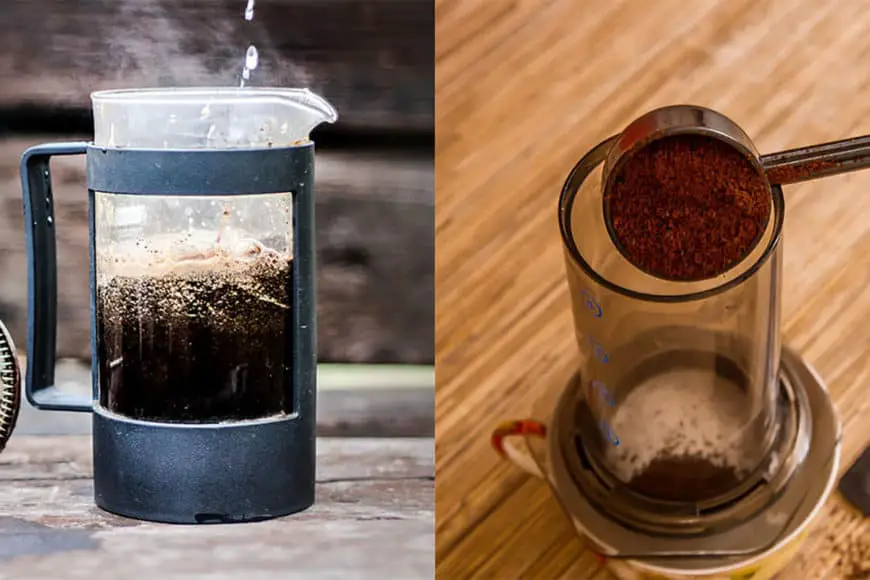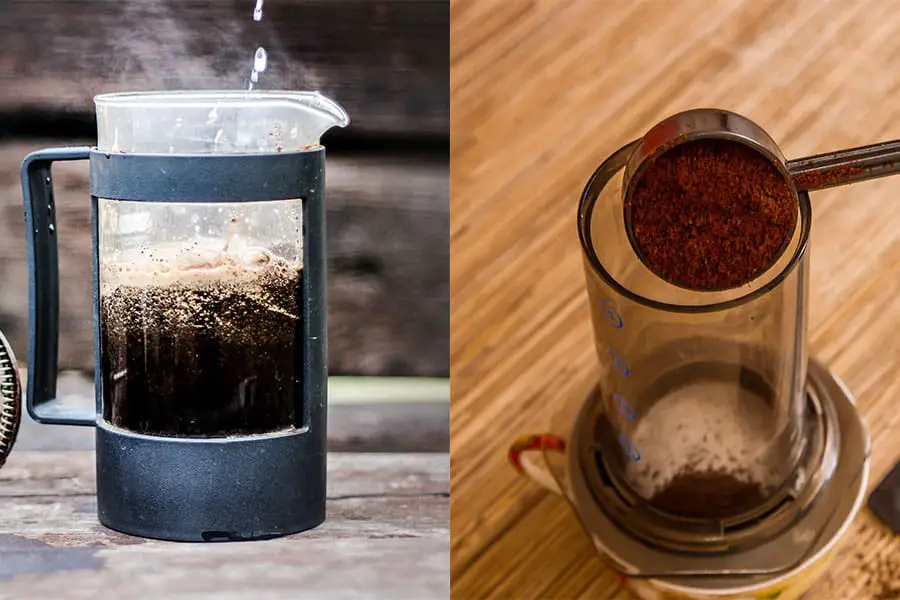
There are lots of different kinds of coffee brewing methods with different strengths and weaknesses, but I’ve always wondered the difference between a French Press and a AeroPress. I wanted to learn more, so I did a little research and here’s what I found.
The Main differences between a French Press and a Aeropress
- Design: Aeropress is a slim tube made of plastic while a French Press is larger and can be made of 4 different types of material
- Grind:- Aeropress uses a medium to fine grind while a French Press use a coarse grind
- Time: – Aeropress brew time is up to 2 minutes while a French Press is 4 minutes
- Taste: – Aeropress has a more subdued taste while a French Press has a more bold taste.
- Amount of Coffee Made: Aeropress makes one cup while a French Press can make a few
In this article I will go over the major differences between the French Press and Aeropress coffee brewing methods and in the end, let you decide which one might work better for you. So, lets get started.
Differences in Design
AeroPress
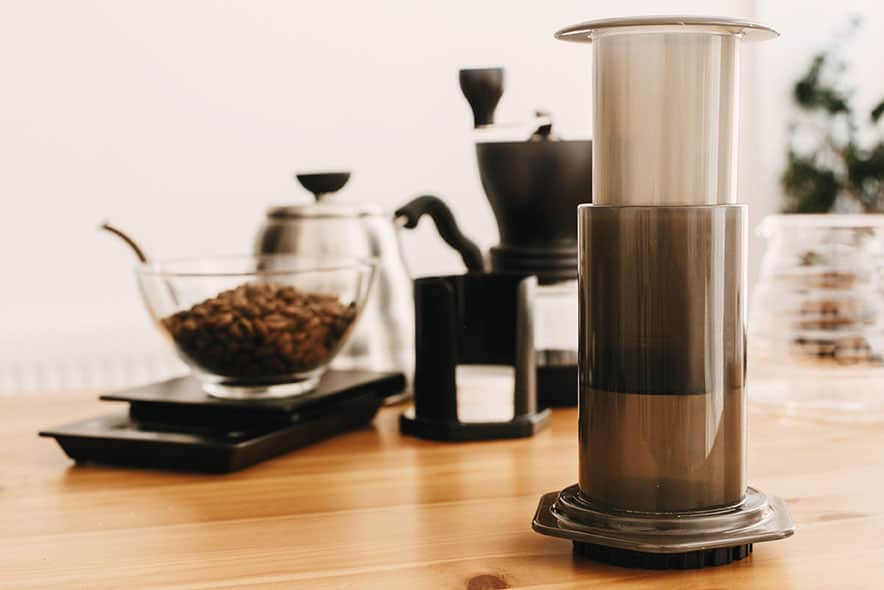
The AeroPress, if you’ve never seen one look at the image above, is a bit unimpressive at first sight, and resembles a big plastic syringe.
It’s comprised of two cylinders – a filtered brewing chamber where fresh ground coffee is placed, typically with a paper filter ( but you can use a metal mesh), and a plunger cylinder that adds pressure to push through hot water, and extracts the coffee into your cup.
French Press
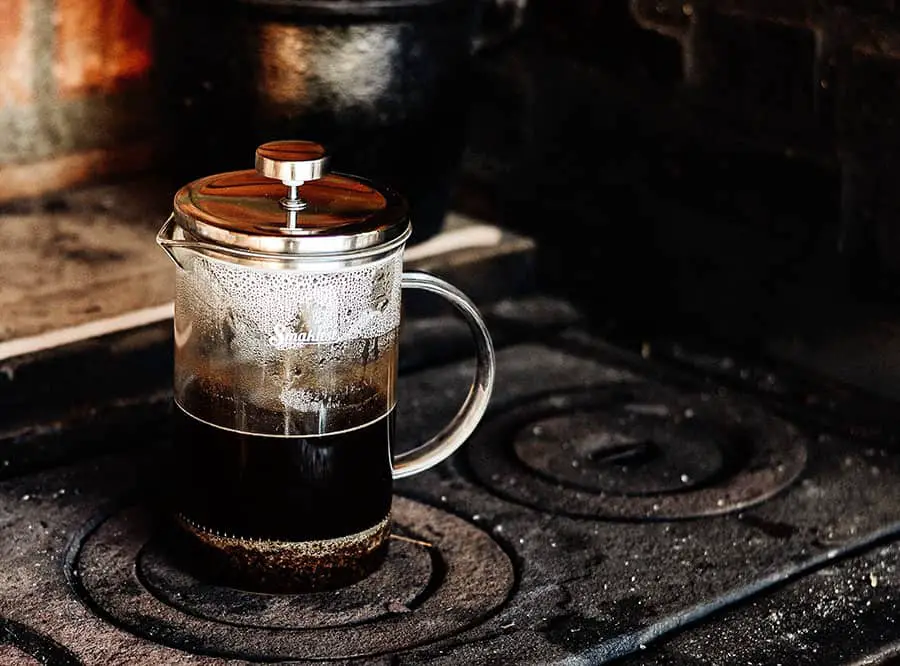
Many people know what the French press looks like but, if not, look at the image above. It is almost as simple as the Aeropress and basically consists of a container can be made of a variety of materials, a screen plunger and a top.
It also, unlike the AeroPress, comes in a variety of sizes from single cup on up. We’ll get to how it works a bit below, but suffice it to say the French press is slightly less manageable than the AeroPress and doesn’t keep the grounds separated from the coffee nearly as well as the Aeropress .
Grind Size and Brewing Method
AeroPress
The Aeropress, unlike the French Press, allows the user to vary a few of the factors that can effect the taste of the coffee. For example with an Aeropress, the pressure it takes to force the water through the coffee is much greater then with a French Press.
The result of this is that you can get a coffee that comes fairly if not pretty darn close to an espresso . This as well other factors such as brew time, coffee to water ratio etc, affect the type of coffee in the cup you get.
French Press
French press, on the other hand provides little to almost no pressure on the coffee. You just pour the coarsely ground coffee into the French Press, add water and wait. This removes a lot of variables, either good or bad, that could effect the coffee taste as all you have to do wait 4 minutes and press the plunger in order to keep the grounds at the bottom.
Time To Make A Cup of Coffee
Aeropress
The AeroPress brewing time is shorter than the French Press. If you are someone on a serious time crunch and you need to have a cup as quick as possible the go with the AeroPress as there recipes that you can use that take as little as about 1:30 to brew (Check out these Aeropress Recipes)
French Press
Compared with Aeropress, it may seem like forever to brew with a French Press as the brew time should be about 4 minutes. If you have a relaxing day with Friends and have some time go with the French Press.
Aroma and Taste
AeroPress
The AeroPress coffee, since it can be used to make an espresso, for some, needs to be diluted because of how concentrated the coffee is after it is brewed. The AeroPress uses a fine grind which allows more soluble solids to be extracted and therefore a fuller more rich taste.
French Press
In addition to the more coarse grind, the metal mesh of the French press allows the suspended solids and aromatic oils to come through which makes for a more mild, lighter tasting flavor, similar to a drip coffee than comes from the AeroPress method.
If you are interested in the comparison between a French Press and Drip Coffee, check out my post
Amount of Coffee
Are you brewing for more than one cup of coffee at a sitting? As of the time of this writing, the AeroPress makes one cup of coffee. Depending on the size you get, the average French press makes about four cups of coffee. And there are larger French presses on the market that brew even larger batches of coffee. (see my article on how to brew with a French Press)
Bottom Line – the Aeropress makes just one cup at a time whereas the French Press can make multiple cups depending on the size that you have.
Which is Coffee Brewer is Easier to Clean?
Bottom line is basically there are both really easy to clean and they have few parts and are taken apart and put back together very easily.
AeroPress
The AeroPress used coffee grounds are simply pressed with a rubber seal through the brewing chamber and into the trash can or for compost.
Then you just rinse out the Aeropress and you’re good to go for your next cup of coffee. This is why, in addition to being light and made out of plastic, that it makes it great for camping or travel.
French Press
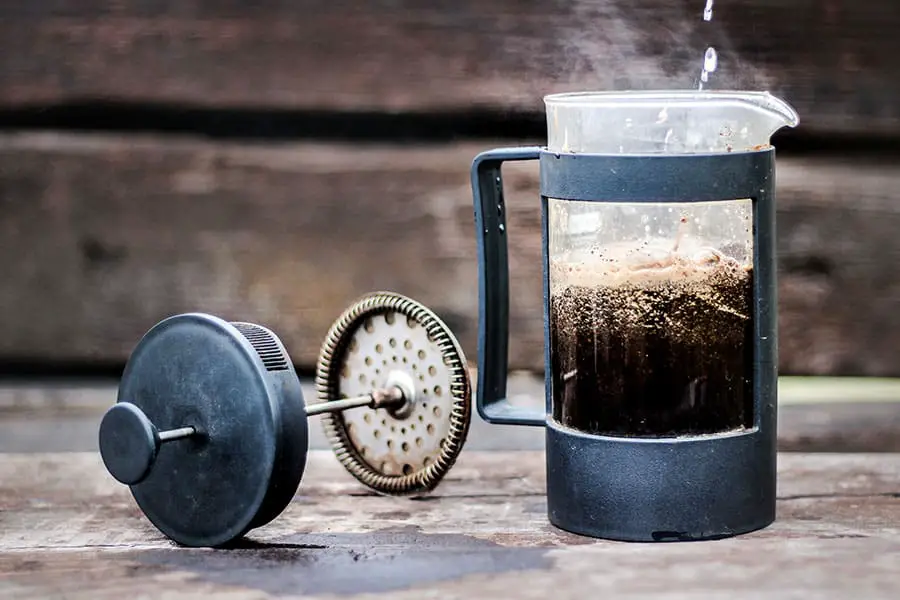
While a French press, usually made of glass, may seem more hygienic and “classier” than its plastic version, it doesn’t mean its any more difficult to clean.
Once done, you simply take the top, remove the plunger and discard the ground coffee ( you can use as compost or other uses). Then just rinse it with water and let dry.
What is Manual Coffee Brewing?
Manual coffee brewing with either a French Press or Aeropress at home or event and the office, has become more popular in recent years. One explanation ( there are many) of the newfound popularity is simply because of the amount of control that can be exercised over the final cup of coffee .
Variables like temperature, amount of pressure, quality and quantity of ground coffee, and water volume can each be altered with the sort of manual brewing options that people are using today.
This results in coffee that can resemble expresso a bit, with more flavors and body when compared with the limited range of results from say the traditional drip coffee machine.
The two most popular manual brewing devices are the newer AeroPress and the older French Press, both of which use immersion as their brewing method, and take some practice to get the intended technique down.
Final Thoughts
Although similar in some respects, The AeroPress and French Press have very different brewing nuances that will appeal to different coffee drinkers and their particular taste preference
If you haven’t yet tried manual brewing with either the newer AeroPress or traditional French Press, go ahead and give one or both a try as neither are are very expensive and it’s well-worth experiencing the difference you’ll enjoy compared the two.
Keep in mind that the Aeropress has less grit and fine silt in the coffee , is quicker to brew and a more rich and robust flavor while the French Press, provides a mild and rounded taste, more similar to a Drip Brew , and is super easy to clean.
Although both manual brewers and techniques take some getting used to, the learning curve is very quick and well worth the time and effort to learn!
If you try the Aeropress check out my article on the best Aeropress Recipes and if you go with the French Press you may want to read my article with more detailed information on how to brew coffee with a French Press.

